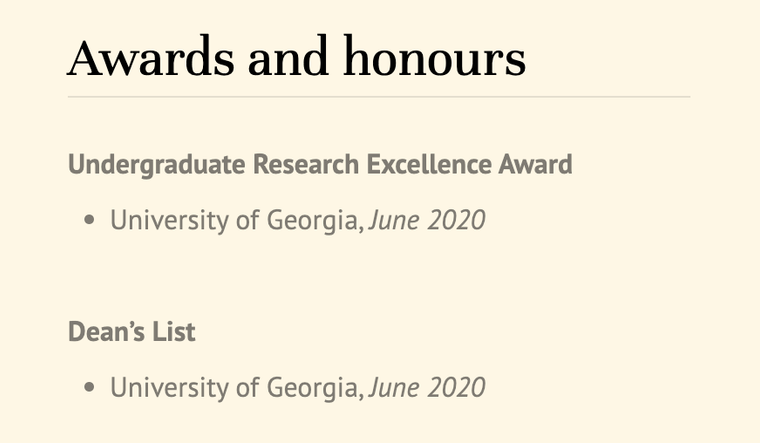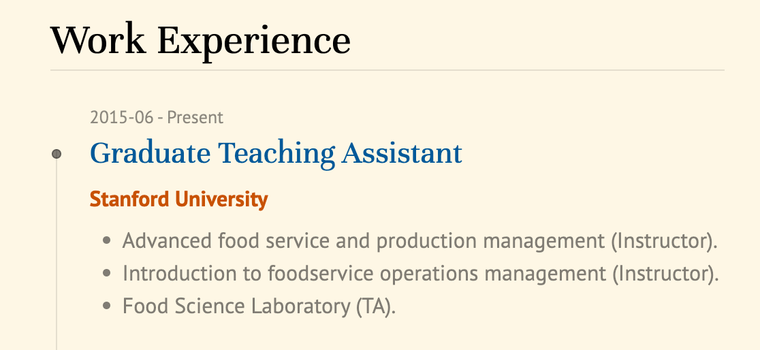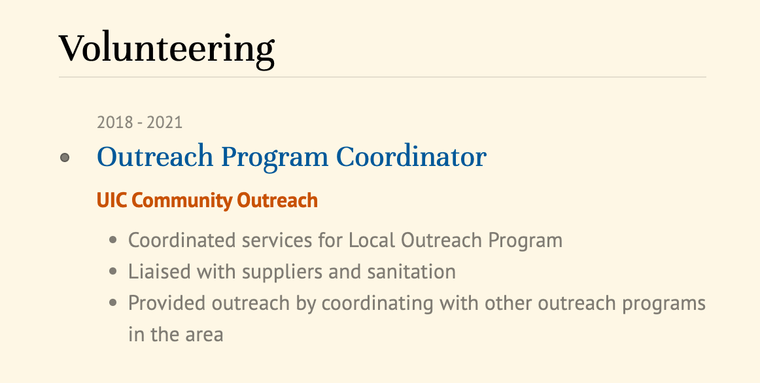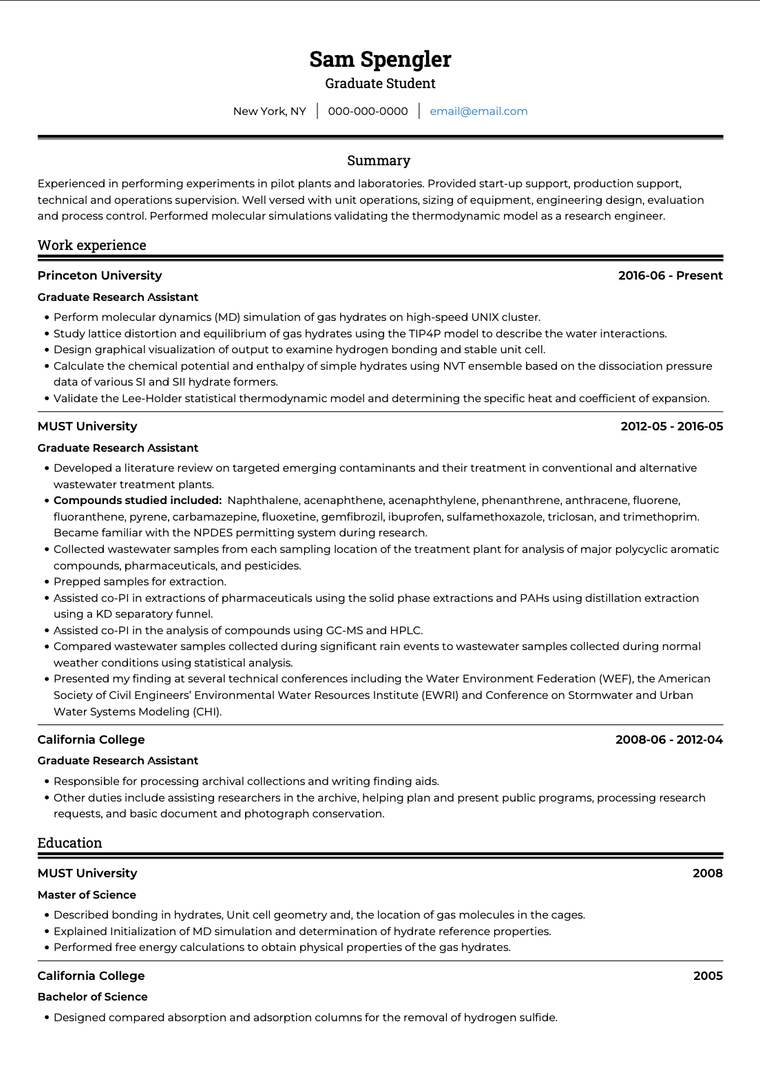


Learning how to write a CV for grad school is an important part of succeeding in higher education. What works for a typical job application might not when you apply for graduate school. In this guide, we will discuss what makes a grad school CV different, what makes a great CV, and what skills and experience to showcase in a grad school CV.
Graduate schools are institutions that award advanced academic credentials, like master's degrees or doctorate degrees. Graduate students need to have a bachelor's degree to qualify for these programs.
Graduate programs are very selective. When you apply for grad school, you'll be competing against some of the nation's best and brightest. Your good grades and accomplishments are important, but they don’t speak for themselves. I you want to be accepted into one of these programs, you'll need a great grad school CV in order to showcase your qualifications properly.
The main difference between a grad school CV and a regular CV is that a grad school CV is written for an academic audience.
This means that it will emphasize educational achievements rather than work experience. This might include academic areas like research areas, publications, grants, presentations, and conferences.
Further, an academic CV should be very focused on the requirements of the academic institution and the specific program. It’s important to make sure your grad school CV has everything required for admission.
Before you consider how to write a CV for grad school, you should confirm that you actually need one.
Your grad school program may not require a CV. Some admissions departments don’t ask for a CV among your application materials. For others, it will be optional.
However, if you have the choice to upload a CV with your application, make sure you do.
A good CV can be a great help to your application, even if it isn’t required. Done right, A CV can summarize all your key skills and qualifications in a page or two. Delivering this information in a clear, concise, and easy-to-read format will improve your application and help you stand out from the crowd.
The exact details of your grad school CV will depend on your academic experience, the graduate program in question, and the application requirements. Common graduate school CV sections include:
Not all of these sections will be applicable to every program, and not all students will have grants, publications, or presentations to include in their CV. When selecting sections, think carefully about what sections are relevant to you and to your circumstances.
It’s important to make your contact information very prominent near the top of your CV. These details have to be easy to find so that anyone who reads your CV will know how to contact you. Make sure your contact information includes:
While the body font of your grad school CV should be around 10pt or 12pt, you can make your name a bit larger, perhaps 16-18pt, so that it stands out when someone first sees your CV.

The Education section is a very important part of a grad school CV. A grad school CV is an academic document, so your academic credentials should be front and centre.
When you write your Education section, list each degree in reverse-chronological order, beginning with the most recent and working backwards. Each item in the Education section should include:
You can also include details like GPA, specializations, research areas, thesis topics, and more if you feel they are relevant.
BSc in Engineering 2018 - 2021 University of Texas Austin, TX
Associates Degree in Engineering 2016 - 2021 NorthEast Texas Community College Mount Pleasant, TX
Research abilities are integral to an academic career, so it’s important to showcase your research experience if you have it. Items in the Research experience section of your grad school CV should include:

If you have teaching, tutoring, or teaching assistant (TA) experience, be sure to include it on your grad student CV. Teaching experience items should include:
While most graduates won’t have direct teaching experience, any TA or tutoring work could help your application.
TA Department of English, University of Colorado 2018 - 2021
Awards and honours show that you have been recognized for your abilities and achievements. Including your awards on your CV is a great way to demonstrate that not only can you perform, others have noticed. An awards and honours section can include:
Unlike the other sections of your grad school CV, it’s best to place awards and honours in order of importance rather than reverse-chronological. If you have only one award to list, you may want to place it in related section, instead of creating a distinct Awards section. For example, a teaching award can go in the Teaching Experience section.
Items in the awards and honours section should include:

If you have been awarded any fellowships or grants, you may want to include them in your CV. For each grant, include:
This section may also include academic scholarships, fellowships, or any other academic work you did for which you received funding. Feel free to edit the section heading to reflect the contents; for example, if you only have scholarships to list, change the title to Scholarships.
American University Emerging Global Leader Scholarship American University, Washington DC 2022
Many graduate school programs will require knowledge of specialist skills, software, or technology. You should read the application thoroughly and pick out the relevant skills you want to showcase, such as using laboratory equipment, software, data analysis techniques, or research.
Programming: JavaScript, Python, C++
Databases: MySQL, Interbase
If you have relevant work experience, you can list it in your CV. List items them in reverse-chronological order, and include:
The experience you include could be either professional or academic, but it’s best to stick to experience that is relevant to your application. Unrelated jobs may not be needed on a grad student CV.
Further, don’t repeat information. If your work experience is all research and tutoring positions, you can list those items in your Research Experience and Tutoring Experience sections, rather than Work Experience.

Publications are integral to an academic career. It’s important to list any books, research papers, journal articles, studies, and any other publications you contributed to.
Publications should be listed according to the citation style of your field: Chicago, APA, MLA, etc.
Mericks, J. A., Jone, A. K., & Hwang, G. B. (2019). A study of Malaria cases in adult populations 8(1), 2-10.
Conferences are a constant in academic life. If you have given presentations or contributed to conferences, you can list your contributions in your CV. The details may include:
Emerging Treatments for Alzheimer’s Disease Dementia Research Group Conference Boulder, Colorado
Professional and academic memberships look great on a CV. If are affiliated with any academic or professional groups, you should include:
American Medical Association (AMA) 2019 - Present
Volunteering experience looks great on a graduate student CV. If you have volunteered in positions relevant to your field, be sure to include them in your CV.
If you want to save space, you can include volunteering experience in your Work History as long as you note that each item is a volunteer position. However, as long as you have a few volunteering positions to showcase, a separate section for volunteer experience is a great way to draw attention to them.

Faculty members and admissions committees screen a lot of grad student CVs when evaluating candidates for their programs. If you want yours to be noticed, you have to make sure it stands out. Here are some tips for writing a great grad student CV:
It’s important to customize your CV to suit the graduate school application. A generic CV that hasn’t been customized with the right details won’t be the right fit. Make sure you read (and re-read) your program's requirements so you know what you need to include.
When you understand what the requirements are, tailor your language, skills, and accomplishments so that the right details are highlighted.
Where a typical CV emphasizes work experience, a grad student CV should focus on academics. Be sure to emphasize your academic achievements, including awards, grants, and publications.
Keep your CV design organized, use a simple font, and give each section a clear heading. This will make the CV easy to read.
Most academic programs will have application requirements. You need to read these policies carefully to ensure your CV is following all the rules. Even if you have a great CV, submitting an application that doesn’t meet the requirements will result in a rejection.
The easiest way to make sure your CV looks great is to use a CV template. When you work with a CV template, you can focus on showcasing your experience without having to worry about the design.
Academia can be a little old-fashioned, so for a grad student CV, a more traditional template, like VisualCV’s ATS or Monte, is likely the best choice.
Experienced in performing experiments in pilot plants and laboratories. Provided start-up support, production support, technical and operations supervision. Well versed with unit operations, sizing of equipment, engineering design, evaluation and process control. Performed molecular simulations validating the thermodynamic model as a research engineer.
Graduate Research Assistant
Graduate Research Assistant
Graduate Research Assistant
Master of Science
Bachelor of Science
Simulation software
Computer Skills
Transcription
Solid Phase Extraction
SigmaPlot
Minitab
Equipment Sizing
Researcher

Table Of Contents